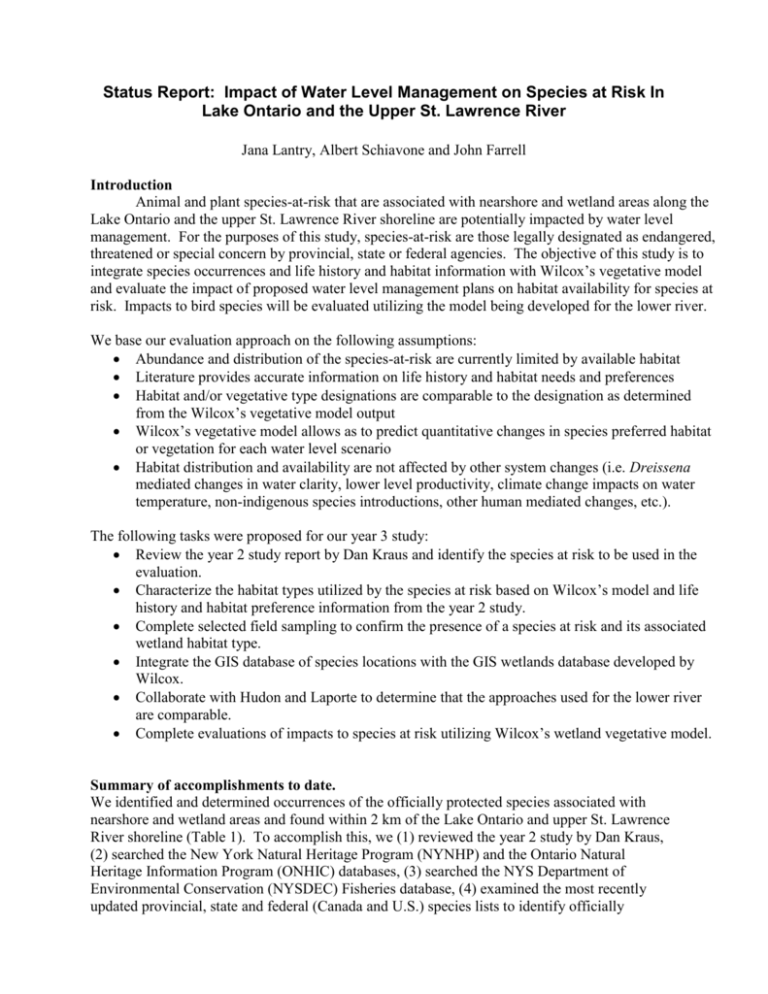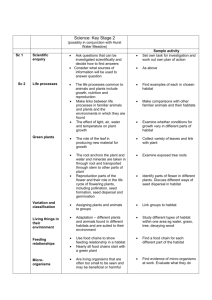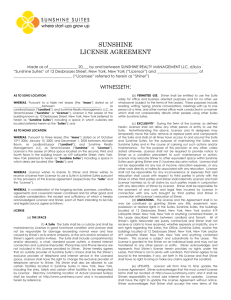LantryReport
advertisement

Status Report: Impact of Water Level Management on Species at Risk In Lake Ontario and the Upper St. Lawrence River Jana Lantry, Albert Schiavone and John Farrell Introduction Animal and plant species-at-risk that are associated with nearshore and wetland areas along the Lake Ontario and the upper St. Lawrence River shoreline are potentially impacted by water level management. For the purposes of this study, species-at-risk are those legally designated as endangered, threatened or special concern by provincial, state or federal agencies. The objective of this study is to integrate species occurrences and life history and habitat information with Wilcox’s vegetative model and evaluate the impact of proposed water level management plans on habitat availability for species at risk. Impacts to bird species will be evaluated utilizing the model being developed for the lower river. We base our evaluation approach on the following assumptions: Abundance and distribution of the species-at-risk are currently limited by available habitat Literature provides accurate information on life history and habitat needs and preferences Habitat and/or vegetative type designations are comparable to the designation as determined from the Wilcox’s vegetative model output Wilcox’s vegetative model allows as to predict quantitative changes in species preferred habitat or vegetation for each water level scenario Habitat distribution and availability are not affected by other system changes (i.e. Dreissena mediated changes in water clarity, lower level productivity, climate change impacts on water temperature, non-indigenous species introductions, other human mediated changes, etc.). The following tasks were proposed for our year 3 study: Review the year 2 study report by Dan Kraus and identify the species at risk to be used in the evaluation. Characterize the habitat types utilized by the species at risk based on Wilcox’s model and life history and habitat preference information from the year 2 study. Complete selected field sampling to confirm the presence of a species at risk and its associated wetland habitat type. Integrate the GIS database of species locations with the GIS wetlands database developed by Wilcox. Collaborate with Hudon and Laporte to determine that the approaches used for the lower river are comparable. Complete evaluations of impacts to species at risk utilizing Wilcox’s wetland vegetative model. Summary of accomplishments to date. We identified and determined occurrences of the officially protected species associated with nearshore and wetland areas and found within 2 km of the Lake Ontario and upper St. Lawrence River shoreline (Table 1). To accomplish this, we (1) reviewed the year 2 study by Dan Kraus, (2) searched the New York Natural Heritage Program (NYNHP) and the Ontario Natural Heritage Information Program (ONHIC) databases, (3) searched the NYS Department of Environmental Conservation (NYSDEC) Fisheries database, (4) examined the most recently updated provincial, state and federal (Canada and U.S.) species lists to identify officially protected species, and (5) reviewed published species-specific life history and habitat information. We characterized important species-specific habitat needs and preferences based on life history and habitat information determined from literature review, selected field sampling, and expected output from Wilcox’s vegetative model. We identified the habitat use associated with critical time periods when water level management could affect a given species, including timing and duration of spawning, nesting (including time to hatching and fledging), and hibernation. Habitat use during non-critical periods was also examined and noted when potentially sensitive to water levels. Finalized summaries and tables for each species included in our study will be complete within the next 2 weeks. We completed selected field sampling to confirm the presence of a fish species-at-risk and its associated wetland habitat type. We seined sites in 11 waterbodies along the Lake Ontario and the St. Lawrence River shoreline (Table 2). These waterbodies were selected based on the species of fish and number of fish species previously captured during NYSDEC sampling and whether or not the waterbody was one of 16 wetland complexes ground-truthed for the vegetative model (Table 2). When possible, for each waterbody we selected sites with different substrate types (clay, silt, sand, gravel, rubble, cobble, woody debris, and combinations of these types), vegetation type and density, and in some cases water flow and depth. At each site seined, we recorded substrate type, dominant vegetative species present (submerged, floating leaf, floating, short emergent and tall emergent), percentage cover of submerged vegetation, number of each fish species captured per seine haul, and GPS coordinates. We took digital photos of each site sampled. Appendix A contains a brief summary of the data collected during selected field sampling. Tasks to be completed by 3/12/04 Determine additional occurrences of species-at-risk that are found beyond 2 km of the shoreline; yet, are in areas still influenced by water level changes. Incorporate the additional occurrences into the study. Complete GIS database of species occurrences and integrate our results with Wilcox’s wetland vegetation model for the same geographic area. Collaborate with Hudon and Laporte to determine that the approaches used for the lower river are comparable. Evaluate the species-specific impact of each proposed regulation plan based on positive or negative change in needed / preferred habitat as estimated by Wilcox’s vegetative model. Use Rank-Sum-Analysis to determine the significance of the positive or negative habitat changes. Evaluate impacts to bird species using the model being developed for the lower river. The final report will be completed by 3/12/04 and will provide a listing of species identified, a GIS database of known locations, a synopsis of important life history and habitat preference information for each species, and results and evaluation of the model. Appendix A. Summary of field data and comparisons of species-specific habitat information (field vs. literature) for legally protected species captured during 2003 sampling. Redfin Shiner (Lythrurus umbratilis) Redfin shiner was historically (1920-1930’s) found in five tributaries to Lake Ontario (Carlson 2001). Johnson Creek is now the only one of these tributaries to currently have a redfin shiner population. We seined one site in Johnson Creek and captured redfin shiner in 2 out of 3 hauls, where it comprised an average of 1.97% (1 SE = 0.97) of the catch. Redfin shiner is most frequently found over relatively hard substrate types composed of sand, gravel, or rock and clay (Scott and Crossman 1973; Matthews and Heins 1984; Smith 1985) and prefer slow, quiet waters of streams (Scott and Crossman 1973; Matthews and Heins 1984; Noltie 1989). We captured redfin shiner over a hard bottom composed of silty clay with some gravel and in an area where there was no to extremely low flow. Redfin shiner inhabits areas with vegetation ranging from none to dense submergent and emergent vegetation (Scott and Crossman 1973; Matthews and Heins 1984; Smith 1985; Noltie 1989) and that vary greatly in turbidity ( Noltie 1989). Our sample site was brown and moderately turbid with submergent vegetation covering approximately 0 – 25% of the area sampled in the 2 hauled areas where redfin shiner was captured. This species often spawns over nests of green sunfish, longear sunfish and orangespotted sunfish (Scott and Crossman 1973; Smith 1985; Noltie 1989). Approximately 1 mile upstream from the site where we captured redfin shiner and later that same day, one longear sunfish was captured with the aid of a backpack electroshocker (Doug Carlson, New York State Department of Environmental Conservation (NYSDEC), personnel communication). This was the first capture of a longear sunfish in Johnson Creek since 1939. Pugnose Shiner (Notropis anogenus) We sampled 6 waterbodies where pugnose shiner was previously caught by NYSDEC and/or SUNY College of Environmental Science and Forestry (Table 2). We have confirmed the captured of one pugnose shiner at Picton Island (Robert Daniels, Curator of Icthyology, NYS Natural History Museum, personnel communication). The habitat of the area where this pugnose shiner was captured is described as an area of clear water, no to slow flow, a silty sand bottom substrate, and dense submergent aquatic vegetation (75-100% cover) dominated by Chara sp. This habitat is comparable to that reported by Scott and Crossman (1973), Smith (1985), Parker et al. (1987), and Carlson (2001). We may have captured pugnose shiner at Sodus Bay and at Garlock and Deer Island Bays in the St. Lawrence River. Robert Daniels Curator of Icthyology at the NYS Natural History Museum will confirm these samples. Bridle Shiner (Notropis bifrenatus) During summer 2003, we captured bridle shiner at 5 of the 7 waterbodies sampled (Table 2). We captured this species at 9 of the 29 total sites seined in these 5 waterbodies. Bridle shiner represented an average of 0.48 – 21.85% of the catch where caught. Bridle shiner represented, on average, < 1.8% of catch at 7 of the 9 sites. The highest average percent of catch occurred at a site in North Colwell Pond, where it represented 28.13% and 15.58% of the catch in the 2 seine hauls performed at that site. Our sampling confirmed published descriptions of bridle shiner habitat. Scott and Crossman (1973), Smith (1985), and Holm et al. (2000) describe bridle shiner habitat as still or slow moving waters with soft substrates of silt, sand and occasionally detritus, clay, or gravel. We caught bridle shiners at sites with no flow (Colwell Ponds, North Pond, Lakeview Pond) or no to very low flow (Deer and Picton Islands). All of these sites had bottom substrates composed of silt or a silt and sand mix. Bridle shiners occupy areas of dense submerged vegetation with adjacent floating and emergent vegetation (Scott and Crossman 1973; Smith 1985; and Holm et al. 2000). Dense submerged vegetation (75 -100% cover) occurred at 5 of the 7 capture sites having relative vegetation density data, and floating and/or emergent vegetation was present at all bridle shiner capture sites. A site in North Pond had moderately dense vegetation (50-75% cover) and one in Lakeview Pond had no submerged vegetation. Bridle shiner habitat information collected during this study was comparable to that found in literature. Rosyface Shiner (Notropis rubellus) We sampled both Johnson Creek and Grass River for rosyface shiner. We did not capture them in Johnson Creek; however, we captured them at 4 of 5 sites in the Grass River (Table 2). At one site, the current was too swift for effective seining; however, rosyface shiner was the only species captured in the 1 haul that we did. At the other 3 sites, rosyface shiner comprised 0.00 73.20% (average = 28.34%; 1 SE = 9.25; caught in 6 of 7 hauls) of the catch. There is little published information on preferred habitat of rosyface shiners. Scott and Crossman (1973), Smith (1985), and Houston et al. (1996) report that this species prefers clear, flowing waters of streams and small rivers with a substrate of clean gravel. We caught rosyface shiners over a variety of substrate types (sandy bottom with rocks and boulders, silty/sand and gravel to only gravel), water depths (approximately 0.5 m - 1.5 m), and relative density of vegetation (0, 5%, 25 - 50%, and 75 - 100% cover). Water flow was slow to moderate at the sites where we captured this species. Eastern Sand Darter (Ammocrypta pellucida) We sampled eastern sand darter in the Grass River, where it had previously been collected by the NYSDEC. We capture this species at 2 of the 5 sites sampled. Eastern sand darter comprised an average of 27.08% (1 SE = 5.45; caught in 4 of 4 hauls) of the catch at one site, and comprised 0.00 – 56.52% (caught in 1 of 3 hauls) of the catch at the other site. We captured them in habitat comparable to that described in literature (Scott and Crossman 1973; Smith 1985; Daniels 1993; Facey 1998). As other authors have previously reported, we caught them over sandy substrate with slow current and only 1 - 5% submerged vegetation. Daniels (1993) reported collections of eastern sand darter in water less than 0.5 m deep. Although we sampled over a range of depths, we collected eastern sand darter only in areas with water <0.75 m deep. Holm and Mandrak (1996) reported that eastern sand darter was found in clear, tea colored and highly turbid streams. We found them in a tanin stained section of the Grass River. Eastern sand darter habitat information collected during this study was comparable to that found in literature. Channel Darter (Percina copelandi) Channel darter is known to occur in only two New York tributaries of Lake Ontario and the St. Lawrence River (to Massena), including the Grass River. In the Grass River, we captured this species at 4 of the 5 sites sampled, where they comprised an average of 2.35% (1 SE = 1.39) of the catch in hauls in which they were caught (5 of 11 hauls). Channel darter typically inhabits sand and gravel bottoms and bars associated with beaches having sluggish currents (Scott and Crossman 1973; Smith 1985). Goodchild (1994) reports their characteristic habitat in Ontario streams as having rock, sand and rubble bottoms, and water over 1 m deep. We captured channel darter over a range of habitat types. Two of the sites with channel darter had sandy bottoms, 0 5% submergent vegetation cover, water depths < 0.75 m, and slow flow. Another site had a sandy bottom with rocks and boulders, 25 - 50% submergent vegetation cover, water depths 1 1.5 m, and moderate flow. The fourth site where we captured channel darter had a silty/sand and gravel to only gravel bottom, 75 - 100% submergent and emergent vegetation cover, water depths 1 - 1.5 m, and slow to moderate flow. Little is reported on the presence, absence, density or type of submergent vegetation that channel darter is associated with (Goodchild 1994). Goodchild (1994) reports that in rivers, channel darter may inhabit deeper pools or sluggish riffles with enough current to create a silt-free gravel substrate (Goodchild 1994). Literature Cited Carlson, D.M. 2001. Species accounts for the rare species of New York, NYS Department of Environmental Conservation, Division of Fish, Wildlife and Marine Resources, Albany, NY. 89 pp. Daniels, R.A. 1993. Habitat of the eastern sand darter, Ammocrypta pellucida. Journal of Freshwater Ecology 8(4): 287-295. Facey, D.E. 1998. The status of the eastern sand darter, Ammocrypta pellucida, in Vermont. Canadian Field-Naturalist 112(4): 596-601. Goodchild, C.D. 1994. Status of the channel darter, Percina copelandi, in Canada. Canadian Field-Naturalist 107(4): 431-439. Holm, E. and N.E. Mandrak. 1996. The status of the eastern sand darter, Ammocrypta pellucida, in Canada. Canadian Field-Naturalist 110(3): 462-469. Holm, E., P. Dumont, J. Leclerc, G. Roy and E.J. Crossman. 2001. Status of the bridle shiner, Notropis bifrenatus, in Canada. Canadian Field-Naturalist 115(4): 614-622. Houston, J. 1996. The status of rosyface shiner, Notropis rubellus, in Canada. Canadian FieldNaturalist 110: 489-494. Matthews, M.M. and D.C. Heins. 1984. Life history of redfin shiner, Notropis umbratilis (Pisces: Cyprinidae), in Mississippi. Copeia 4(2): 385-390. Noltie, D.B. 1989. Status of redfin shiner, Notropis umbratilis, in Canada. Canadian FieldNaturalist 103(2): 201-215. Parker, B. J., P. McKee and R.R. Campbell. 1987. Status of pugnose shiner, Notrpis anogenus, in Canada. Canadian Field-Naturalist 101(2): 203-207. Scott, W.B. and E.J. Crossman. 1973. Freshwater fishes of Canada. Fisheries Research Board of Canada, Bulletin 184, Ottawa, CA. 966 pp. Smith, C.L. 1985. The inland fishes of New York State. New York Department of Environmental Conservation, Division of Fish, Wildlife, and Marine Resources, Albany, NY. 522 pp.









